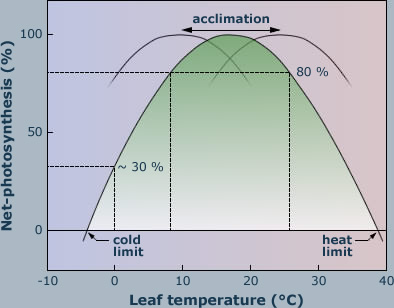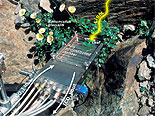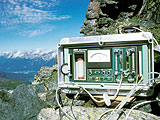 |
|
|
|
|
|
|
The net photosynthetic uptake of CO2 by leaves of alpine plants is largely driven by the duration of the season (or leaf longevity) and by the light regime. Cloudy weather or snow cover restrict CO2-assimilation. Temperature itself is not a problem for photosynthesis for three reasons:
|
1 - Temperature response of leaf photosynthesis (idealised) |
These insights have emerged from measurements of leaf gas exchange in situ, i.e. without removing plants form their natural habitat. During such measurements, leaves are enclosed in an air conditioned chamber through which air is pumped at a known rate. Leaves absorb part of the CO2 which passes through the chamber (Fig. 2). This depletion of CO2 in the test air can be measured by using an infrared gas analyser (Fig. 3). Remember: photosynthetic CO2 uptake per unit of leaf area of alpine plants is high, and not different from lowland plants. CAM and C4: Alpine plants commonly use the C3 mode of photosynthesis, but there are a few C4 grasses near treeline and some plants use crassulacean acid metabolism (CAM) (see Alpine plants and water). |
2 - Δ[CO2] is a measure of the photosynthetic rate of the leaf. 3 - Infrared gas analyser at 2600 m in the Alps (in 1985, when these instruments were still bulky). |
29 August 2011 |
||
| |
||


